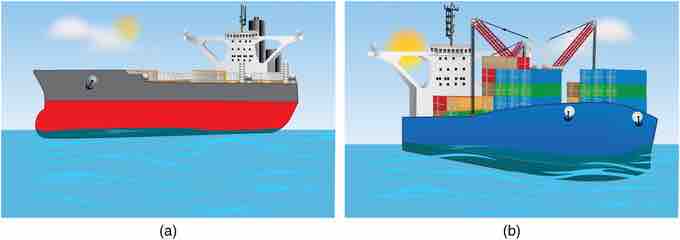Why do some objects float, but others don't? If you put a metal coin into a glass of water it will sink. But most ships are built of metal, and they float. So how is this possible?
Condition for Flotation
An object will float if the buoyancy force exerted on it by the fluid balances its weight, i.e. if
But the Archimedes principle states that the buoyant force is the weight of the fluid displaced. So, for a floating object on a liquid, the weight of the displaced liquid is the weight of the object. Thus, only in the special case of floating does the buoyant force acting on an object equal the object's weight. Consider a one-ton block of solid iron. As iron is nearly eight times denser than water, it displaces only 1/8 ton of water when submerged, which is not enough to keep it afloat. Suppose the same iron block is reshaped into a bowl. It still weighs one ton, but when it is put in water, it displaces a greater volume of water than when it was a block. The deeper the iron bowl is immersed, the more water it displaces, and the greater the buoyant force acting on it. When the buoyant force equals one ton, it will sink no further.
When any boat displaces a weight of water equal to its own weight, it floats. This is often called the "principle of flotation" where a floating object displaces a weight of fluid equal to its own weight. Every ship, submarine, and dirigible must be designed to displace a weight of fluid equal to its own weight. A 10,000-ton ship must be built wide enough to displace 10,000 tons of water before it sinks too deep in the water. The same is true for vessels in air (as air is a fluid): A dirigible that weighs 100 tons displaces at least 100 tons of air; if it displaces more, it rises; if it displaces less, it falls. If the dirigible displaces exactly its weight, it hovers at a constant altitude.
Flotation and Density
Density plays a crucial role in Archimedes' principle. The average density of an object is what ultimately determines whether it floats. If its average density is less than that of the surrounding fluid, it will float. This is because the fluid, having a higher density, contains more mass and thus more weight in the same volume. The buoyant force, which equals the weight of the fluid displaced, is thus greater than the weight of the object. Likewise, an object denser than the fluid will sink. The extent to which a floating object is submerged depends on how the object's density is related to that of the fluid. For example, an unloaded ship has a lower density, and less of it is submerged compared with the same ship loaded with cargo . We can derive a quantitative expression for the fraction submerged by considering density. The fraction submerged is the ratio of the volume submerged to the volume of the object, or

Density and Submersion
An unloaded ship (a) floats higher in the water than a loaded ship (b).
The volume submerged equals the volume of fluid displaced, which we call
where
There are a couple things to note about this expression:
- Note that it mentions the average density of the object. This can be much less than the density of the material the object is made of. For instance, a steel ship is actually mostly filled with air (think of the corridors, cargo holds, etc.), so its average density is between that of air and steel. To be more precise, the average density is defined as the total mass of an object divided by its total volume:
$\bar{\rho} = m/V$ . - This formula makes sense only if the density of the object is smaller than the density of the fluid. Otherwise, the fraction submerged becomes greater than one—a sign that the object does not float at all, but it sinks!